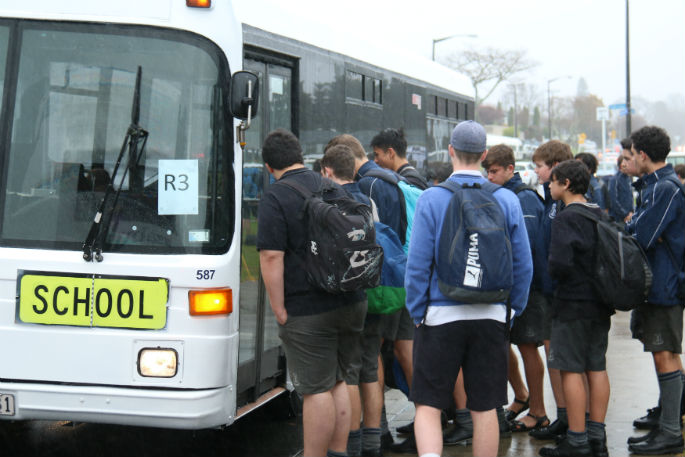School bus services are being squeezed and a greater number of college students are expected to walk or cycle to school, as part of a number of recommendations approved by the Regional Council Public Transport Committee.
By reducing passengers from 1450 to 1160 and the number of school bus services from 45 to 24, the council expects to reduce service costs from the current $860,000 to $330,000.
The bus kilometres travelled daily come down from 1700 to 780 and the subsidy per passenger drops from $1200 to $370.
'It's called fare box recovery and its split three ways,” says committee chairman Lyall Thurston.
'The passenger makes a contribution, the NZTA makes a contribution and the council makes a contribution.
'In terms of ratepayers the Tauranga ratepayers are subsidising a lot of the public transport in Tauranga through their rates. When you get on a bus in Tauranga the fare is basically split about three ways. You are certainly not paying the full cost recovery of the trip.”
Under the new contract, now expected to roll out sometime in 2018, operating costs reduce from $2.6m to $1.1m, while fare revenue reduces by $300,000 from $1m to $700,000.
Additional costs arising from the new school bus programme include $30,000 allocated for crossing guards.
A number of schools have been identified as having students crossing major roads as an impediment to use of the public bus service and a safety risk for students.
A trial crossing guard proposal is being proposed that aims to put a trained individual in place to guide students, monitor and report adverse behaviours.
The regional council is also looking at putting $100,000 towards a Safe Travel Bus Programme to be run by the city council, looking at incorporating bus travel into a school's travel planning and providing education programmes for schools, particularly aimed at intermediate age children.
While the biggest savings have come from reducing the number of services and kilometres travelled by school. This means that buses are expected to be more crowded and that most students will have longer distances to walk to reach their nearest school bus stop.
The new services are intended to run as close to public bus routes as possible while providing good access to schools. An estimated 1450 students currently use School Hopper services and 1,160 will continue to have access to these services.
Of the 290 students likely to lose service 100 of these may be eligible for Ministry of Education transport assistance, 100 are from Tauranga Girls' and Boys' colleges, 40 from Otumoetai College and Intermediate, and the remainder are from the remaining schools.
The majority of students who will no longer have access to school services are located on a direct public bus route to their school with the remainder largely being served by the public bus network.



7 comments
Good
Posted on 31-08-2017 07:33 | By Tgaboy
Get more kids biking. That may help prevent obesity, increase resilience and help make them more road aware and safety conscious for when the become drivers themselves. When I grew up in the 80's and 90's there was a greater percentage of kids biking. Now seems they are too lazy to make the effort. This in turn takes the heat off the council to ensure that they provide self cycle ways.
Walk - Yeah right
Posted on 31-08-2017 08:23 | By Scoop
They won't be walking or cycling, they will be getting mum or dad to take them to school in the car, creating bigger traffic jams. It amazes me how the powers that be can't see this.
golly gosh
Posted on 31-08-2017 08:43 | By old trucker
This is terrible, You dont expect kids to walk do ya, for crying out loud, do them a world of good,gosh in my day to be taken to school in a car was like being king,there use to be over 400 bikes in the racks next to the Armoury shed,we had NO problem then kids biked for miles like i did, (8) miles each way, loved it, fit and healthy, you never saw any OBESITY then at all,you cannot get out of Cambridge rd to turn right to Tauriko because of parents taking their cottonwool kids to school all kids should be dropped off at stop by BP and taken by bus this would stop this MAYHEM their. my thoughts only, Bringing us the BEST NEWS in NZ is Sunlive,being No1, is BEST,Thankyou, 10-4, out, phew.
Reality check
Posted on 31-08-2017 08:50 | By backofthequeue
The Regional Council Public Transport Committee expect students to walk or cycle to school. Tauranga motorists should thus expect an increase in peak hour traffic flows. It happened in 2015 when central government ceased school bus funding and this unrealistic cost-benefit recommendation from the RCPTC will only provide a similar outcome if adopted.
@ old trucker
Posted on 31-08-2017 10:10 | By MISS ADVENTURE
Exactly right, the Govt dropping school buses and now local councils also only creates one problem. Wait for it, kids on bikes and so on knocked over by cars etc, a few deaths then it will all be put back as it was. This is a cost saving thing, thats all. No common sense to it at all. Cottonwool lids with 'helicoper' parents.
walk or bike
Posted on 31-08-2017 20:27 | By Capt_Kaveman
on fine days use local bus on rainy days if over 3kms then they should pay to use a bus to an outside school
Old School
Posted on 02-09-2017 07:43 | By Minib
I walked to school for many years and it was the norm back there most kids did and we didn't know any different as few of my friends families had cars and there was no buses. A good raincoat and away we would go.
Leave a Comment
You must be logged in to make a comment.